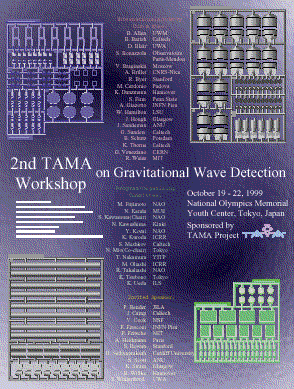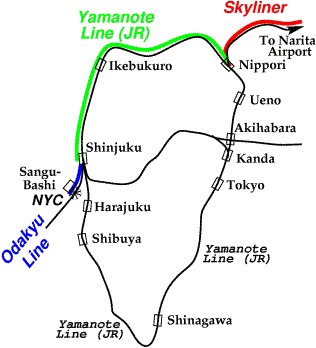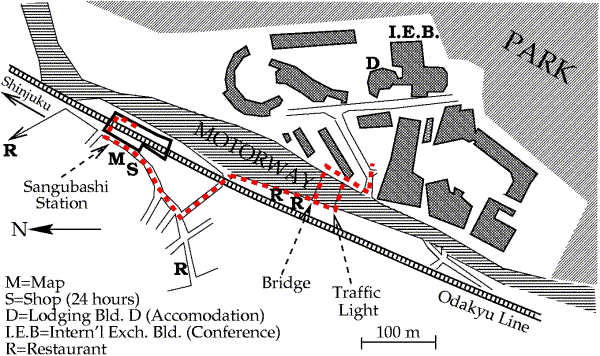 Contents
Contents Objective
Organization
Conference Site
Transportation
Conference Office and Registration
Accommodation and Travel
Currency
Program
Proceeding
Miscellaneous
Further Information
Important Request
 Contents
Contents
Objective
Organization
Conference
Site
Transportation
Conference
Office and Registration
Accommodation
and Travel
Currency
Program
Proceeding
Miscellaneous
Further Information
Important
Request
While the detection of gravitational
waves has long been a dream of physicists and astronomers, recent
developments give us hope that it may soon become reality. In
particular, we have reached the stage where large-scale interferometers
are being planned and built that should be able, within a few
years, to detect gravitational waves from plausibly expected sources.
We wish to establish the field
of "gravitational wave astronomy" which will provide
new knowledge about the Universe that cannot be obtained from
other techniques such as optical or radio astronomy.
Several projects around the world have already begun to construct large-scale laser interferometric gravitational wave detectors (in particular, LIGO, VIRGO, and GEO600. Here in Japan we started the TAMA project in 1994 to develop a laser interferometer with a 300-m baseline (TAMA300). While this year (1999) is the final year of the initial five-year project, an extension seems probable.
The workshop will be organized
similar to the first TAMA Workshop in 1996. The emphasis of this
second workshop will be on discussion of the results of TAMA300,
which is expected to be in its final phase of completion at the
time of the workshop, as well as on the current status of the
other projects. In addition, there will be discussions of both
established and new advanced techniques in various related fields
which are necessary to improve the sensitivity of gravitational
wave detectors.
The workshop will have ten
invited speakers and some contributed papers, but no poster session.
| International Advisory | Program/Organizing |
|---|---|
| Committee: | Committee: |
| B. Allen, UWM | M. Fujimoto, NAOJ |
| B. Barish, Caltech | N. Kanda, MUE |
| D. Blair, UWA | S. Kawamura (Chair), NAOJ |
| S. Bonazzola, Observatoire Paris-Meudon | N. Kawashima, Kinki Univ. |
| V. Braginskii, Moscow | Y. Kozai, NAOJ |
| A. Brillet, CNRS-Nice | K. Kuroda, ICRR |
| R. Byer, Stanford | S. Meshkov, Caltech |
| M. Cerdonio, Padova | N. Mio (Co-chair), Univ. Tokyo |
| K. Danzmann, Hannover | T. Nakamura, YITP |
| S. Finn, Penn State | M. Ohashi, ICRR |
| A. Giazotto, INFN Pisa | R. Takahashi, NAOJ |
| W. Hamilton, LSU | K. Tsubono, Univ. Tokyo |
| J. Hough, Glasgow | K. Ueda, ILS |
| J. Sandeman, ANU | |
| G. Sanders, Caltech | |
| B. Schutz, Potsdam | |
| K. Thorne, Caltech | |
| G. Veneziano, CERN | |
| R. Weiss, MIT |
The National Olympics Memorial Youth Center (NYC) in central Tokyo has been chosen as the conference venue. This center is a national youth educational facility established with the aims of "promoting the sound development of youth and youth education in Japan" and has an international conference hall and accomodations. The mail address is:
National Olympics Memorial
Youth Center,
3-1, Yoyogi Kamizono-cho, Shibuya-ku,
Tokyo 151-0052,
Tel: 03-3467-7201,
Fax: 03-3467-7797
More information can be obtained from the Web page of the center. The workshop will take place in the international conference room in the "International Exchange Building", whereas accomodation is provided in the adjacent "Lodging building D" (See also the transportation map and the section on accomodation below).
Please note that the word
"Tokyo" refers to
(a) The huge area known as
"Tokyo to" (Tokyo prefecture) which extends some 40
km to the west from downtown, but also
(b) the train station called
"Tokyo eki" (Tokyo station) in central Tokyo.
Therefore, buying a train ticket
to "Tokyo" will probably only get you to that train
station, which is still far from the conference venue. It is necessary
to specify more precisely your destination, e.g. Shinjuku or Sangubashi.
Here is a simplified overview of the relevant train lines for
accessing the conference venue (NYC) and the TAMA site at NAOJ:

(this map is also available as an EPS file.)
The conference venue, NYC,
is located near Shinjuku in central Tokyo.
Most participants will arrive
at Narita
Airport which is about 60 km east of central Tokyo.
Going from Narita to NYC
involves 2 steps:
(1) From
Narita to Shinjuku (60 km), and
(2) from
Shinjuku to NYC (2 km).
Narita airport provides an overview
of transportation between the airport and the city. The most important
information is also collected below.
There are essentially two options: train or bus. Taking a taxi has no advantage and is prohibitively expensive.
By
Train
Several train lines run between
Narita and Tokyo. They are fast, reliable and not too expensive.
However, in some cases you will need to change trains.
Narita airport -[JR Narita Express] - Shinjuku station
It takes about 80 min from
Narita to Shinjuku (3110 yen). Please see the
Web page of Narita Express in order to obtain more detailed
information such as timetables. Some
of Narita Express trains go to other destinations and do not reach
Shinjuku station.
If you have
a ticket with a reserved seat number, please try to board the
correct wagon of the train (it may not be possible to walk all
through the train after departure).
Narita airport -[Keisei Skyliner] -Nippori Station -[JR Yamanote-line]- Shinjuku station

More information on Skyliner
trains can be obtained from the
Keisei Web page.
on Odakyu-line ![]() ("Odakyu sen"), which starts from Shinjuku station.
("Odakyu sen"), which starts from Shinjuku station.
Shinjuku station is said to be the busiest train station in the world, and may be a little bit confusing for people who come there the first time. But don't worry, there are some English signs. What you need to look out for is the Odakyu-line. Its entrance is at the western end of Shinuku station. Note that "Odakyu" is also the name of a huge department store which is located next to the train line entrance. While there are many signs for various things called "Odakyu", the train station is generally labelled as "Odakyu Line".
Before entering the platform, you have to buy a ticket (130 yen) from a vending machine. Please take care to use a "Odakyu" line ticket vending machine (not "JR" or "Keio"). Keep the ticket because you need to return it when leaving the station at the end of your journey.
Only
"local" trains ![]() ("Kaku-eki-tei-sha")
stop at Sangubashi station.
("Kaku-eki-tei-sha")
stop at Sangubashi station.
Please do not
use "homeway", "limited express", "express"
or "semi express" trains. Local trains start from platforms
8 and 9 (which are on the lowest level underground). The stations
that you pass through are
Shinjuku (departure)
- Minami Shinjuku - Sangubashi (get off here).
Although taking trains in Tokyo may be a little bit confusing at first, it is generally very fast, efficient and safe. If you accidentially go too far (e.g. by taking an Odakyu express train you might end up in "Yoyogi-Uehara" or "Shimokitazawa"), don't worry, just go back with the next train without leaving the station or buying a new ticket. If you don't know the fare to your destination, or if it turns out that the ticket you bought was too cheap for the distance travelled, there are "fare adjustment machines" at every station where you can pay the missing amount. Tokyo trains do not run during the night, the last trains usually depart around midnight. The last Odakyu local trains for Sangubashi leave Shinjuku at 0:52.
From Sangubashi station
you have to walk about 300m to get to the NYC center.
NYC has a map
of the surrounding area. Here is a simple map showing your way:

(This map is also available as an EPS file.)
It is also possible to take a taxi from Shinjuku station
to NYC. The fare should be around 1000 Yen.
The Japanese name of the center is:
![]() ,
,
which is read "Kokuritsu orinpikku kinen seishoonen soogoo
sentaa".
Important
Request:
Since
we need to know your arrival time at NYC in order to organize
the accommodation, please inform the conference secretariat beforehand
(by e-mail) about your flight schedule or planned arrival time.
Also, if you do not arrive at Narita airport or if there are any problems concerning transportation, please contact the conference secretariat.
During the conference, our
office will be in Meeting Room B near the conference room. On
Monday and Saturday, we will have a desk on the first floor (=ground
floor) in the accomodation building D.
Registration will take place
at this office on Monday afternoon/evening and Tuesday morning.
The planned opening hours are:
| Monday, 18 | 15:00-21:00 | Building D (1st floor) |
| Tuesday, 19 | 8:30-18:00 | Int. Exch. Bld. Meeting Room B (2nd floor) |
| Wednesday, 20 | Closed | |
| Thursday, 21 | 8:30-18:00 | Int. Exch. Bld. Meeting Room B (2nd floor) |
| Friday, 22 | 8:30-13:00 | Int. Exch. Bld. Meeting Room B (2nd floor) |
| Saturday, 23 | 8:00-10:00 | Building D (1st floor) |
Participants must pay the
registration fee and the accommodation fee at the registration.
The registration fee is 20,000 yen (including the banquet, the
coffee breaks and the proceedings) and the accommodation fee is
4,300 yen per night. An additional banquet fee of 5,000 yen per
person is required for accompanying persons. (It is possible to
register for the workshop on that day even if you did not submit
the registration form beforehand, however, we would prefer advance
registration if possible.)
Payment
must be in cash, in Japanese Yen. Unfortunately no credit cards, travelers'
checks etc. can be accepted (see the section about money)
Student discount: There is a discounted registration fee for students, 10,000 yen instead of 20,000. Please bring your student ID with you for the registration.
The accommodation rooms
are in Lodging Building D. They are available from Monday (18th),
15:00 until Saturday (23rd), 10:00. Unfortunately, they cannot
be used before 15:00 on Monday, and there are no facilities to
store luggage in NYC. There are, however, luggage lockers at most
train stations. The room keys will be handed out at the registration
desk on Monday. The check-out time is 10:00. Please return
the key to the registration desk on your departure day.
The main gate of NYC and the
entrance of Lodging Building D are always open. However, if you
enter the main gate late at night (after 23:00), a guard at the
main gate may inquire the name of the organization/workshop.
In this case, please show the first page of this second circular.
Please note that NYC is not a full-service hotel. NYC
has asked us to provide you with the following information:
page 1. page 2.
page 3. page 4.
table of restaurants and other services.
You will get copies of these pages upon your arrival.
Unfortunately it is impossible
to extend the stay in NYC before or after the workshop. Furthermore,
as mentioned above, NYC is established for the education of young
people, and hence accommodation for men and women is separate.
If you require other accomodation,
there are many hotels in the city of Tokyo that are not far from
NYC; some examples of hotels near Shinjuku are:
| Name of Hotel | Typical room charge | Telephone | FAX |
| Shinjuku Washington Hotel | 11,000 yen | +81-3-3343-3111 | +81-3-3342-2575 |
| Hotel Sunlight Shinjuku | 8,500 yen | +81-3-3356-0391 | +81-3-3356-1223 |
The room charge is for a single room and does not include tax. If you wish to book a room, find other hotels, or obtain information on travel in Japan, please contact the following person:
Mr. Norihiko GOTO
Toranomon International Travel
Department
Kinki
Nippon Tourist
1-1-21 Toranomon, Minato-ku,
Tokyo 105-0001
Tel: +81-3-3502-2925
FAX:+81-3-3593-9572
e-mail: ptra-intl@or.knt.co.jp
Some general information can also be obtained from one of the following websites:
Japan National Tourist Organization
Tokyo Convention and
Visitors Bureau
Lonely
Planet Japan Guidebook Update
Subways
in Tokyo or another
subway map
The Japan Times Online
(English newspaper)
The Daily Yomiuri
Online (English newspaper)
JSL's Japan Headline
Page (News about Japan)
Tokyo Classified
(weekly events)
Japan Information
Network (some links)
The Japan Web Guide
(some links)
Tokyo now online (some
links)
The only useful currency
in Japan is the Japanese Yen. Please note that the use
of credit cards, travelers' checks etc. is not very widespread
in Japan, and many payments (such as for train tickets or the
conference fee) must be made in cash. It is recommended that participants
exchange money beforehand at Narita airport. There are several
banks near Shinjuku station, where exchange of U.S. dollars and
major European currencies is available. However, these banks do
not offer significantly better rates than the banks at
Narita, and their opening times are rather limited. Hence it is
recommended that you have enough Japanese money before leaving
Narita airport. Note that most Japanese ATM machines will
not accept international credit cards. When you leave Japan,
you can re-exchange unused Yen at the airport.
As a rough guide, an inexpensive dinner costs around 1000 Yen,
while a better dinner including a drink may be around 2000-3000
Yen.
You can find the current value of the yen at http://www.oanda.com.
| Breakfast | 7:00-9:00 | 490 yen |
| Lunch | 11:30-13:30 | 640 yen |
| Dinner | 17:00-19:00 | 690 yen |
| Breakfast | 7:00-9:00 | 650 yen |
| Lunch | 11:30-14:30 | 800-1600 yen |
| Light meal and Tea | 14:30-17:00 | 500-600 yen |
| Dinner | 17:00-22:00 | from 1000 yen up |
Topics that will be presented and discussed are as follows: project status, laser and optics, interferometer, isolation and thermal noise, sources, theory and data analysis, others. Ten invited talks and contributed talks are planned. The TAMA Session is planned for the second day of the workshop; the session will be held at the campus of National Astronomical Observatory of Japan (NAOJ) in Mitaka where the TAMA 300 detector is being developed and the TAMA Site Tour is also scheduled.
Below is an overview of the program, while the detailed program is on a separate page.
Oct. 19 (Tue)
| 8:30 | - | 9:20 | Registration |
| 9:20 | - | 9:30 | Opening Talk |
| 9:30 | - | 10:45 | Project Status (I) |
| 11:10 | - | 12:00 | Project Status (II) |
| 1:35 | - | 2:30 | Project Status (III) |
| 2:50 | - | 4:50 | Interferometer (I) |
Oct. 20 (Wed)
TAMA Session in NAOJ
Mitaka
Transportation by bus between NYC and NAOJ will
be provided.
| 10:00 | - | 11:25 | TAMA Session (I) |
| 11:25 | - | 2:00 | TAMA Tour and Lunch (in the NAO cafeteria) |
| 2:00 | - | 4:00 | TAMA Session (II) |
| 4:25 | - | 5:35 | TAMA Session (III) |
Oct. 21 (Thu)
| 8:35 | - | 9:55 | Thermal Noise (I) |
| 10:20 | - | 11:40 | Thermal Noise (II) |
| 1:15 | - | 2:20 | Data Analysis/Theory (I) |
| 3:05 | - | 4:30 | Data Analysis/Theory (II) |
| 6:00 | - | 8:00 | Banquet |
Oct. 22 (Fri)
| 8:35 | - | 9:40 | Laser and Optics |
| 10:05 | - | 11:30 | Suspension & Isolation |
| 1:05 | - | 2:50 | Interferometer (II) |
| 2:50 | - | 3:00 | Closing Talk |
Universal Academy Press (UAP) is to publish the proceedings of the workshop. Authors are encouraged to use LaTeX with the style file provided by UAP. The instruction (TeX file) and style files for the proceedings are available from the following ftp site:
Host
Name: ftp.uap.co.jp
User ID: anonymous
Password: (please enter your
E-mail address)
Path in our Site: pub/proceedings/tama2/
File Name: tama.tex, figure.eps,
ta.sty, ma.sty, epsf.sty (5 files)
Please note that the deadline for contributions is 30 November, 1999. Instructions on how to submit the manuscript are also included in the TeX file.
For any questions or further information, please don't hesitate to contact the conference secretariat:
Secretariat of the 2nd TAMA
Workshop
National Astronomical Observatory
of Japan
Mitaka, Tokyo, 181-8588, JAPAN
E-mail: tamaws@gravity.mtk.nao.ac.jp
Phone: +81-422-34-3620
Fax: +81-422-34-3793
WWW:
http://tamago.mtk.nao.ac.jp/tama/tamaws/tamaws2.html
The program/organizing committee would like to thank G. Heinzel for his help with this web page.
We wish you a pleasant journey and look forward
to seeing you in Tokyo soon.
![]()